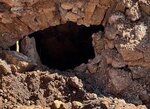


It’s basically a big hole in the ground, but the Durham Township supervisors and members of the Durham Historical Society are intrigued by its discovery and believe it may be much more than that.
In the spring, Durham Township Roadmaster Peter Cox stumbled on the mysterious underground structure when he was looking for something else.
He was digging for soil samples near the site of a proposed equipment shed when he uncovered a stone portion of what he thought could be an old root cellar, he told the township supervisors.
To protect it, Cox quickly covered the hole with a steel plate and now the Durham Historical Society has brought in an expert in historic buildings to take a look at the structure to determine its age and help decide what to do with it.
At the time of its discovery, township officials thought it might be good to restore it and perhaps use it as an educational tool to show children and others how root cellars used the natural cooling, insulating and humidifying properties of the earth to supply fresh vegetables through the winter months.
But David Oleksa, society president, told them at the August meeting that it may not be a root cellar. He said Kathryn Auerbach, a historic preservation instructor at Bucks County Community College, had visited the site and said she’s not so sure it was a root cellar.
It is basically 12 feet long, 7 feet wide and 7½ feet deep. At one point, though, it measures 14 feet from floor to ceiling.
The township property on Old Furnace Road is part of a complex that includes the iconic Durham Grist Mill situated on the foundation of the original Durham Furnace, which began operations in 1727.
The furnace produced cannon balls for the Revolutionary War and some historians claim it also provided ammunition for the earlier French and Indian War.
Oleksa said Auerbach told him it could have had another purpose, such as the storage of materials for the old Durham Furnace, or even weapons.
Oleksa said others theorized it could even have served as a hiding place in case of attacks after the Walking Purchase of 1737 soured relationships between settlers and natives.
At any rate, Auerbach noted the stone arch was carefully constructed and she said she believed the underground structure should be preserved.
“This is pre-Revolutionary War country up here,” said Oleksa. “and research is ongoing. We may still find out the purpose of the building.”
In other business, the supervisors announced they had received a Dirt and Gravel Grant in the amount of $13,077. The funds will be used to complete roadwork projects.
The supervisors also reported PennDOT had completed a traffic study and lowered the speed limit on Durham Road in the township to 35 miles per hour. The action came as a response to township officials’ concerns about speeding after residents complained to them about cars traveling too fast for the country road.
Join our readers whose generous donations are making it possible for you to read our news coverage. Help keep local journalism alive and our community strong. Donate today.